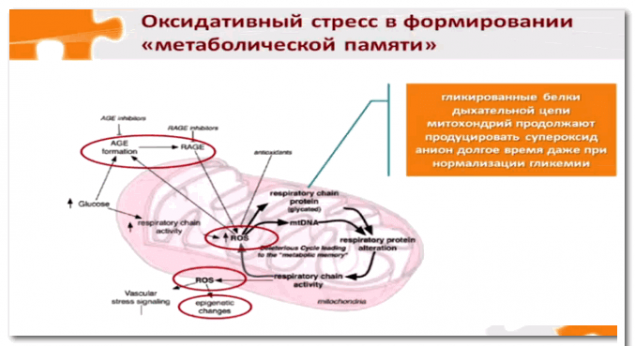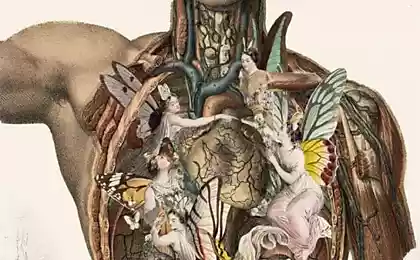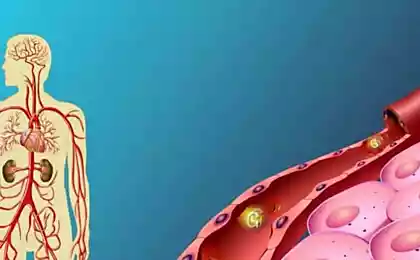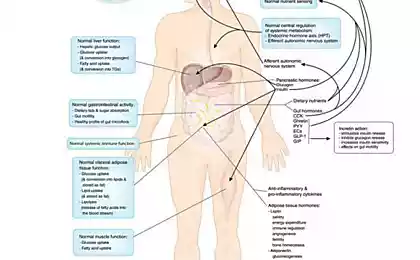681
Metabolic memory and aging
Today let's talk about that ages us and slowly killing since birth — glycation (glycosylation, glycation) of proteins is a consequence of the Maillard reaction and the phenomenon of metabolic memory.
Modern life and progress gives us a great chance to live a long and healthy, but they also create a lot of obstacles (temptations), who lead the man away from the goal — productive to healthy longevity.
What is aging?
In the beginning of XX century average life expectancy was only 40-45 years. Now the numbers rolled over 70 years old.
In connection with the increase in life expectancy and other factors began to emerge diseases that were unknown in previous centuries. Many simply did not live up to cancer, dementia, diabetes, heart attacks and other socially significant diseases.
The problem of eternal youth, always standing there, at all times, and only now scientists were able to approach the beginning of unraveling this seductive and alluring mystery.
There are many hypotheses and proven mechanisms of aging of the human body. One such mechanism is the theory of glycation of the protein structures of the body. Please note that the word aging, I do not mean only the appearance (wrinkles, sagging skin and other lesions of the skin with age).
Aging occurs at all levels of the structure of any tissue and internal organs: from DNA, to entire systems. And this mechanism is glycosylation, or glycation, also called the glycation of proteins, suitable for every organ and system. Let's take a closer look at what this destructive process.
What is glycosylation, glycation and glycation
Essentially all three terms refer to the same thing — a complex chain of biochemical reaction between:
Advanced glycation end products have enormous destructive effect, and in the English interpretation sound like Advanced Glycosylation End-products or in short AGE. Surprisingly, in translation into Russian the word AGE means AGE. Interestingly, scientists deliberately came up with this name or not?
By the way, this process happens in normal, but in small quantities, and the organism can quickly fix the violations. As it happens with cancer cells, which every day appear, but the immune system does not allow them to degenerate into a tumor.

But when simple carbohydrates becomes very much, damage is accumulated, the accumulated number of AGE and aging is accelerated, and acquired comorbidities.
If you think that to blame only sweets and pastries, then you are wrong. Complex carbohydrates (oligo - and polysaccharides) that are found in cereals, grains, pasta, starchy vegetables, fruits if absorbed in the digestive tract are broken down to monomers (glucose, fructose, etc.). So eat a bowl of buckwheat, rest assured that the level of monosaccharides in an hour or two you will be high enough.
I do not call to completely eliminate starchy foods, but to intelligently approach the selection of foods and not to feed illusions, that once you eat sweets, then you are all right.
Sugar has many names. Here are some of them: high fructose corn syrup, "high fructose corn syrup", GFS, HFCS, GFS, sucrose, maltose, corn syrup, molasses, cane sugar, corn sugar, raw sugar, honey, fruit concentrate, maple syrup, powdered malt, corn and its derivatives, rice and corn syrup, treacle, molasses, raw, dried cane syrup, invert sugar, brown rice syrup, white grape juice or other fruit concentrates.
AGE result:
The Maillard reaction?
This reaction is found not only in vivo but also in cooking. Flavorful crispy brown crust on bread, boiled condensed milk, fried potatoes, seared steak — they all share a high level AGE.
This reaction can be compared with the reaction of caramelization, as a result, the product becomes brown due to the formation melanoidins pigments. Therefore, these substances are not only formed in our body, but also come to us with food. Who else would fried potatoes?

The process of formation of the ultimate toxic products multi-stage, partially irreversible and universal always — whether it's a piece of meat or a vascular wall of a man.
AGE of body does not appear. They may be displayed only with the change of cells, i.e. when the damaged tissue is completely renewed. But if a structural element is changed every 100 years, such as collagen?
The scary thing is that the process of glycation is a fully Autonomous process, it does not need special enzymes that can be inhibited by drugs. To the reaction was the right temperature and the substrate, i.e. simple sugar in the bloodstream. The more blood sugar is, the more formed the final products of glycosylation.
Recall the analysis of glycated hemoglobin. It is not that other, as damage to the hemoglobin molecule by attaching glucose molecules. In this form, hemoglobin can not perform its functions. Well, that red blood cells live only 3 months, and then in their place stand new, pristine!
What is the metabolic memory?
The phenomenon of metabolic memory (hyperglycemic memory and of vascular memory) means that the high blood glucose levels is memorized in the cells and tissues, namely the retina, blood vessels, kidneys, peripheral nerves. And despite the subsequent normalization of blood glucose levels in these tissues are ongoing pathological processes causing the complication.
If the period of hyperglycemia lasted a long time, that memory only gets stronger. This phenomenon is directly related to AGE, which I mentioned above, as well as with oxidative stress. Scientists believe that glycation of DNA and mitochondrial proteins may cause such a phenomenon and maintain it for a long time.
And it requires considerable time to this genetic material recovered. And I am absolutely sure and I am not alone. Foreign authors (e.g., Jack Kruse) that genes determine only 30% of our health for the rest 70% we are responsible.
People in the power itself to affect gene expression through lifestyle changes, diet, and replenishment of nutrients, physical activity and even what he thinks, i.e. the power of thought.
The study of these abilities is called Epigenetics, i.e. literally "Medgenetics".
After prolonged hyperglycemia, pathological processes stop immediately. This is impossible as it is to quickly stop the train, moving at full speed. The recovery takes time, maybe even more than a period of decompensation. Therefore, to normalize the level of sugar we need to think now! If you are really valuable to their health, then lay all your "can't", "don't want", "no time" and other excuses.
Everyone is waiting for when the time comes, but time somehow just goes away...
This article I wanted to show the importance of rapid normalization of blood sugar in the primary detection of diabetes or disorders of glucose tolerance.
The main thing is reducing the consumption of carbohydrates, as a way to reduce the level of glycation of the structural proteins of the body and prolong youth, delaying aging.
For patients with diabetes type 1 need to aim faster to deal with the intricacies of insulin, not to spare money, time and effort on a good compensation in the early years, maybe the first 10-15 years after diagnosis. This recommendation pravomochny and for people with type 2.
If you do not care now will regret resources, it will be even worse, have to pay for their inaction.published
Author: Lebedev D., endocrinologist
P. S. And remember, only by changing their consumption — together we change the world! ©
Source: //saxarvnorme.ru/glikaciya-glikozilirovanie-glikirovanie-i-reakciya-majyara.html
Modern life and progress gives us a great chance to live a long and healthy, but they also create a lot of obstacles (temptations), who lead the man away from the goal — productive to healthy longevity.
What is aging?

In the beginning of XX century average life expectancy was only 40-45 years. Now the numbers rolled over 70 years old.
In connection with the increase in life expectancy and other factors began to emerge diseases that were unknown in previous centuries. Many simply did not live up to cancer, dementia, diabetes, heart attacks and other socially significant diseases.
The problem of eternal youth, always standing there, at all times, and only now scientists were able to approach the beginning of unraveling this seductive and alluring mystery.
There are many hypotheses and proven mechanisms of aging of the human body. One such mechanism is the theory of glycation of the protein structures of the body. Please note that the word aging, I do not mean only the appearance (wrinkles, sagging skin and other lesions of the skin with age).
Aging occurs at all levels of the structure of any tissue and internal organs: from DNA, to entire systems. And this mechanism is glycosylation, or glycation, also called the glycation of proteins, suitable for every organ and system. Let's take a closer look at what this destructive process.
What is glycosylation, glycation and glycation
Essentially all three terms refer to the same thing — a complex chain of biochemical reaction between:
- amino acids (read: protein),
- fats,
- DNA
- free monosaccharides (glucose, fructose, ribose, galactose and others),
Advanced glycation end products have enormous destructive effect, and in the English interpretation sound like Advanced Glycosylation End-products or in short AGE. Surprisingly, in translation into Russian the word AGE means AGE. Interestingly, scientists deliberately came up with this name or not?
By the way, this process happens in normal, but in small quantities, and the organism can quickly fix the violations. As it happens with cancer cells, which every day appear, but the immune system does not allow them to degenerate into a tumor.

But when simple carbohydrates becomes very much, damage is accumulated, the accumulated number of AGE and aging is accelerated, and acquired comorbidities.
If you think that to blame only sweets and pastries, then you are wrong. Complex carbohydrates (oligo - and polysaccharides) that are found in cereals, grains, pasta, starchy vegetables, fruits if absorbed in the digestive tract are broken down to monomers (glucose, fructose, etc.). So eat a bowl of buckwheat, rest assured that the level of monosaccharides in an hour or two you will be high enough.
I do not call to completely eliminate starchy foods, but to intelligently approach the selection of foods and not to feed illusions, that once you eat sweets, then you are all right.
Sugar has many names. Here are some of them: high fructose corn syrup, "high fructose corn syrup", GFS, HFCS, GFS, sucrose, maltose, corn syrup, molasses, cane sugar, corn sugar, raw sugar, honey, fruit concentrate, maple syrup, powdered malt, corn and its derivatives, rice and corn syrup, treacle, molasses, raw, dried cane syrup, invert sugar, brown rice syrup, white grape juice or other fruit concentrates.
AGE result:
- to endothelial dysfunction, and she in turn to atherosclerosis,
- to mitochondrial dysfunction and injury of the nervous tissue (polyneuropathy, Alzheimer's disease, multiple sclerosis and other cognitive disorders),
- the bonding of the molecules of collagen and elastin connective tissue (wrinkles, lesions of the vessel walls, impaired glomerular filtration of kidney, lesion of the articular ligaments, bones, and other tissues),
- to lose DNA
- to the stimulation of oxidative stress, i.e., oxidation.
The Maillard reaction?
This reaction is found not only in vivo but also in cooking. Flavorful crispy brown crust on bread, boiled condensed milk, fried potatoes, seared steak — they all share a high level AGE.
This reaction can be compared with the reaction of caramelization, as a result, the product becomes brown due to the formation melanoidins pigments. Therefore, these substances are not only formed in our body, but also come to us with food. Who else would fried potatoes?

The process of formation of the ultimate toxic products multi-stage, partially irreversible and universal always — whether it's a piece of meat or a vascular wall of a man.
AGE of body does not appear. They may be displayed only with the change of cells, i.e. when the damaged tissue is completely renewed. But if a structural element is changed every 100 years, such as collagen?
The scary thing is that the process of glycation is a fully Autonomous process, it does not need special enzymes that can be inhibited by drugs. To the reaction was the right temperature and the substrate, i.e. simple sugar in the bloodstream. The more blood sugar is, the more formed the final products of glycosylation.
Recall the analysis of glycated hemoglobin. It is not that other, as damage to the hemoglobin molecule by attaching glucose molecules. In this form, hemoglobin can not perform its functions. Well, that red blood cells live only 3 months, and then in their place stand new, pristine!
What is the metabolic memory?
The phenomenon of metabolic memory (hyperglycemic memory and of vascular memory) means that the high blood glucose levels is memorized in the cells and tissues, namely the retina, blood vessels, kidneys, peripheral nerves. And despite the subsequent normalization of blood glucose levels in these tissues are ongoing pathological processes causing the complication.
If the period of hyperglycemia lasted a long time, that memory only gets stronger. This phenomenon is directly related to AGE, which I mentioned above, as well as with oxidative stress. Scientists believe that glycation of DNA and mitochondrial proteins may cause such a phenomenon and maintain it for a long time.
And it requires considerable time to this genetic material recovered. And I am absolutely sure and I am not alone. Foreign authors (e.g., Jack Kruse) that genes determine only 30% of our health for the rest 70% we are responsible.
People in the power itself to affect gene expression through lifestyle changes, diet, and replenishment of nutrients, physical activity and even what he thinks, i.e. the power of thought.
The study of these abilities is called Epigenetics, i.e. literally "Medgenetics".
After prolonged hyperglycemia, pathological processes stop immediately. This is impossible as it is to quickly stop the train, moving at full speed. The recovery takes time, maybe even more than a period of decompensation. Therefore, to normalize the level of sugar we need to think now! If you are really valuable to their health, then lay all your "can't", "don't want", "no time" and other excuses.
Everyone is waiting for when the time comes, but time somehow just goes away...
This article I wanted to show the importance of rapid normalization of blood sugar in the primary detection of diabetes or disorders of glucose tolerance.
The main thing is reducing the consumption of carbohydrates, as a way to reduce the level of glycation of the structural proteins of the body and prolong youth, delaying aging.
For patients with diabetes type 1 need to aim faster to deal with the intricacies of insulin, not to spare money, time and effort on a good compensation in the early years, maybe the first 10-15 years after diagnosis. This recommendation pravomochny and for people with type 2.
If you do not care now will regret resources, it will be even worse, have to pay for their inaction.published
Author: Lebedev D., endocrinologist
P. S. And remember, only by changing their consumption — together we change the world! ©
Source: //saxarvnorme.ru/glikaciya-glikozilirovanie-glikirovanie-i-reakciya-majyara.html























